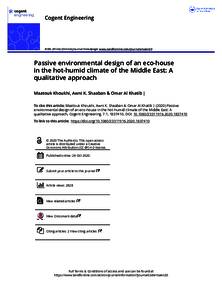وثيقة
Passive environmental design of an eco-house in the hot-humid climate of the Middle East : a qualitative approach.
المعرف
DOI: 10.1080/23311916.2020.1837410
المصدر
Cogent Engineering. v. 7, 1, 1837410
المساهمون
Shaaban, Awni K. , مؤلف
Al-Khatib, Omar., مؤلف
الدولة
United Kingdom.
مكان النشر
London
الناشر
Cogent OA.
ميلادي
2020-01-01
اللغة
الأنجليزية
الموضوع
الملخص الإنجليزي
The increase of energy consumed by buildings in the Middle East is mainly due to the harsh weather that forces people to spend more time indoors. Moreover, the provision of a building’s indoor thermal comfort condition is achieved by an active cooling system. Further, designing buildings without taking into consideration proper design of the building form, orientation, and appropriate selection of the envelope materials can lead to a considerable increase of heat and energy use. Therefore, an appropriate approach to develop an architectural design incorporating passive environmental solutions related to the climate and the site is a must for achieving thermal comfort with less energy consumption. The Research Council of Oman has launched a competition to design, construct, and operate buildings that embrace sustainability principles. One of the eco-friendly buildings was investigated by the academic institution in Oman (Sultan Qaboos University). The objective of this eco-house project is to develop an innovative residential house that is aesthetically pleasing and functionally working, economic, technically feasible, energy-efficient, climatically appropriate, and socio-culturally acceptable. It is of utmost importance in prototype housing development to use appropriate materials which can be produced locally which would meet the climatic, technical, and aesthetic needs. This paper is intended to develop guidelines for assessing the constraints of a climate environment that supports and promotes a prototype of a sustainable house (i.e., eco-house) in the hot-humid climate of Oman.
ISSN
2331-1916
قالب العنصر
مقالات الدوريات

